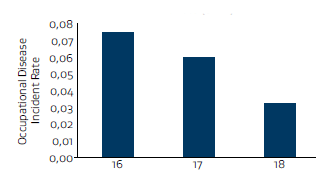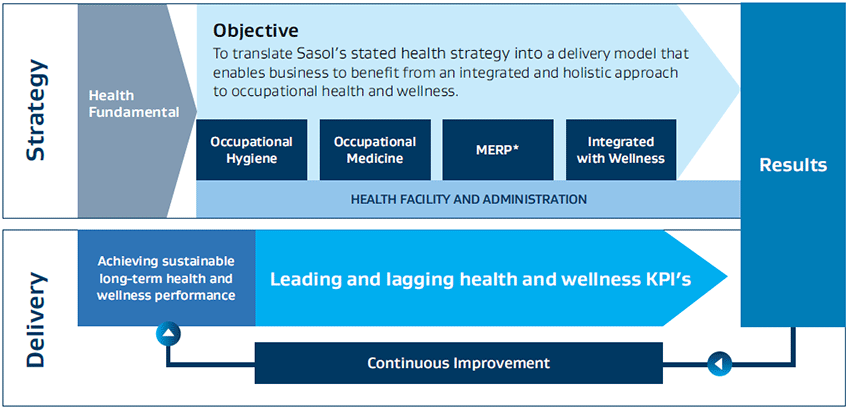Ensuring a healthy workforce
We apply a holistic approach to employee health and wellbeing. Through our risk-based, integrated occupational health and wellness framework, we aim to achieve long-term health and wellness performance, thereby maintaining a healthy workforce that is able to work safely and productively for the duration of their careers.
REDUCING OCCUPATIONAL EXPOSURE
One of our key objectives is to manage our employees’ occupational exposure. We do this by identifying health hazards and assessing the risk to health. We also quantify relevant exposure to either eliminate or reduce such exposure to chemical and physical health stressors through specific controls in the workplace.
Our risk-based approach also allows us to evaluate, analyse, monitor and manage long-term exposure to occupational health stressors and provide preventative measures for a range of occupational health risks. This includes a hierarchy of controls for known exposure, from at-source elimination through engineering design, to exposure reduction strategies, including administrative controls and the provision of suitable personal protective equipment.
SUPPORTING HEALTH AND WELLNESS SERVICES
An occupational health system enablement project was launched for our Southern African operations. Its objective is to support health and wellness services through an integrated risk-based management system. Organisational health performance profiles, based on key industry leading and lagging health and wellness indicators, will now be made possible using accurate data. In turn, this informs continuous health and wellness improvement initiatives towards maintaining a healthy workforce.
Governance on occupational health has also been optimised through the setting of performance requirements and facilitating integration into other business areas.
MANAGING OCCUPATIONAL HEALTH
We seek to manage and prevent occupational, work-aggravated and lifestyle diseases. To achieve this, we focus on the early detection of occupational diseases, and aim to reduce incapacities due to work related and lifestyle diseases. Our injury on duty and medical emergency management programmes include medical emergency response planning.
In the reporting period, further improvement was recorded in the number of statutory reported occupational diseases, down to 29 from 39 in the previous financial year. This contributed to an improved occupational incident rate (ODIR) of 0.03.
Occupational Disease Incident Rate (ODIR)

This downward trend can be ascribed to a variety of factors which includes the application of coal dust suppression initiatives at our mining operations. The deployment of engineering, administrative and personal protective equipment controls resulted in meeting our equipment-noise reduction milestone targets. As a leading indicator to prevent future occupational diseases from occurring, we continue to identify and monitor non-reportable work related noise induced hearing loss cases. We also continue to closely monitor occupational and biological exposure for potential and known exposure to identified carcinogens and teratogens within the petrochemical environment. In our medical surveillance processes, we have improved proactive diagnostic screening. This, together with our improved understanding of noise effects and insights from dust monitoring, delivers an optimised control regime.
Importantly, we retain our ongoing focus on hearing conservation and dust suppression initiatives for our operations. This is to ensure mitigation of noise-induced hearing loss (NIHL) and lung disease (predominantly coal-worker’s pneumoconiosis at our operations in South Africa), with these being the most frequently reported occupational diseases across the Group.
Enabling employee wellness
Sasol’s wellness vision is to provide an infrastructure for wellness related benefits that supports our employee value proposition. We aim to optimise the wellness of our employees with a multidimensional approach, including information sharing, education and empowerment of employees so that they can ultimately take responsibility for their own wellness.
Our three wellness-focus areas with underlying components are as follows:
MANAGEMENT
Components:
- HIV/AIDS (see our HIV Wellness focus story)
- Lifestyle diseases
- Health plans
WELLNESS
Components:
- Employee assistance programme
- Financial wellness
MANAGEMENT
Components:
- Absenteeism management
- Death benefits
- Disability benefits
- Retirement plans
Supporting health and wellness services
An occupational health system enablement project was launched for our Southern African operations. Its objective is to support health and wellness services through an integrated risk-based management system. This system will provide accurate data derived from key industry leading and lagging health and wellness indicators, which will enable the development of an integrated health profile for our South African operations. We have optimised our governance approach for occupational health to include the setting of performance requirements and the integration of health with other business areas such as wellness and human resources. Overall, this will achieve sustainable long-term health and wellness performance.
Occupational Health Governance Framework
Our Occupational Health Governance Framework helps position integration to deliver sustainable health and wellness results.

* Medical emergency response plan

